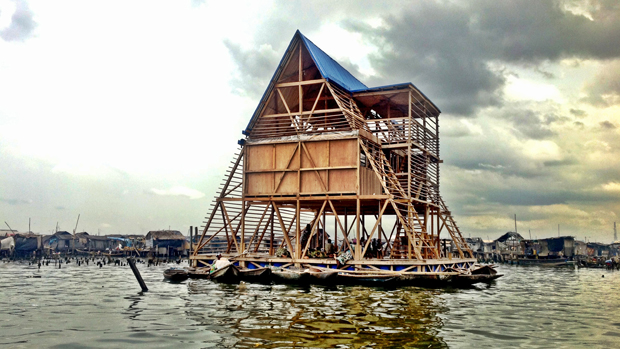Floating schools and folding helmets: eight amazing designs
Highlights from the 2014 design of the year awards shortlist, compiled by London's Design Museum

THE Design Museum in east London has unveiled 76 candidates for its prestigious design of the year awards 2014. The list includes a floating school, a fold-away helmet, and a modular mobile phone that could last you for the rest of your life.
The shortlist also includes radical designs from the architect Zaha Hadid, designer Tracy Neuls, and fashion designer Miuccia Prada.
The competition comprises seven separate categories: architecture, product, furniture, fashion, graphic, digital and transport. Previous winners include the London Olympic torch, and the UK Government's website.
The Week
Escape your echo chamber. Get the facts behind the news, plus analysis from multiple perspectives.

Sign up for The Week's Free Newsletters
From our morning news briefing to a weekly Good News Newsletter, get the best of The Week delivered directly to your inbox.
From our morning news briefing to a weekly Good News Newsletter, get the best of The Week delivered directly to your inbox.
Below are eight highlights from the judges' selection.
Metro Trains, Dumb Ways to Die - designed by McCann Melbourne

Spanning a website, an app, and a viral YouTube video, this multimedia project aims to teach children about everyday risks with cute cartoon characters who meet their untimely demise in comically gruesome fashion. The main aim of the project is to teach children to be safe around trains. One unexpected side-effect may be its positive impact on the fashion community – last year Kate Moss told The Guardian that Dumb Ways to Die was her favourite app.
Phonebloks - designed by Dave Hakkens
A free daily email with the biggest news stories of the day – and the best features from TheWeek.com

What if you could buy a smartphone that would last you for the rest of your life? This was the dream of Dutch designer Dave Hakkens, whose 'Phonebloks' concept aims to decrease waste by offering consumers the opportunity to replace individual components of their phone, while retaining the device's basic frame. In theory, Hakkens believes that choosing separate components could enable users to personalize their mobile phone to their own specifications, adding an improved camera, increased storage or a larger battery, without having to throw the device away and get a new one.
Touch Board: Interactivity Everywhere - designed by Bare Conductive

Turn your wall into a lightswitch, turn your posters interactive, turn any surface into a sensor of any kind. Bare Conductive, a group of London-based designers, last year mounted a KickStarter crowdsourcing campaign to develop a new device that would work with their electrically conductive paint. The Touch Board will allow creative types to make all manner of homegrown projects including interactive books, distance sensors, or sound installations.
The Seaboard Grand - designed by Roland Lamb and Hong-Yeul Eom

The Seaboard is a "tech forward" interpretation of the piano that attempts to reimagine what a keyboard can do. The Seaboard takes the basic layout of a piano but allows a player to "bend" the sound of each note by using a range of different gestures that its inventor Roland Lamb says are based very closely on the gestures people learn when they first pick up the piano. Moving a finger left on a key makes a note 'bend' downwards, moving it right makes it go up a little. Jazz singer Jamie Cullum is among those to have tried the Seaboard.
Ripple, ultra-light timber table - designed by Benjamin Hubert

Designer Benjamin Hubert built a 2.4 metre timber table that could comfortably seat eight dinner guests and is so light it can easily be picked up by one person. The table is made from corrugated Sitka spruce plywood, and is regarded as both environmentally friendly and easy to build and manoeuvre.
Makoko Floating School, Nigeria - designed by NLE, Makoko Community Building Team

The Makoko community in Lagos, Nigeria have dealt with life on the water for many years. Houses in the area are built on stilts and navigated, during floods, by canoe. A prototype for a floating school has been developed by Nigerian-born architect Kunle Adeyemi, whose radical design aims to address challenges faced by the community such as climate change and rapid urbanisation.
Silk Pavilion - designed by Mediated Matter Group at the MIT Media Lab

The silk pavilion is a structure built collaboratively by robots and silk worms. The basis for the structure was comprised of polygonal panels made of silk laid down by a CNC machine. It was then completed by an army of 6,500 silk worms who traversed its surface depositing silk fibres.
Bloom Helmet - designed by Tokyo Safety

The bloom helmet can be folded down for easy storage, then restored to its full shape in less than a minute. It is designed to provide protection to people who live in earthquake-prone areas.
The 76 projects will be shown at the Design Museum from 26 March to 25 August 2013. Winners will be announced later in the year.
-
 Unemployment rate ticks up amid fall job losses
Unemployment rate ticks up amid fall job lossesSpeed Read Data released by the Commerce Department indicates ‘one of the weakest American labor markets in years’
-
 The Week contest: Octopus album
The Week contest: Octopus albumPuzzles and Quizzes
-
 Hegseth rejects release of full boat strike footage
Hegseth rejects release of full boat strike footageSpeed Read There are calls to release video of the military killing two survivors of a Sept. 2 missile strike on an alleged drug trafficking boat